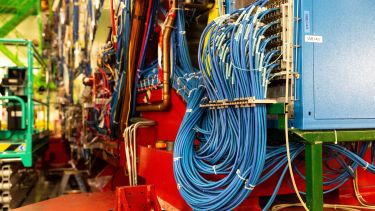Radiation environment simulation and qualification
Our work on the simulation and understanding of the radiation environment in ATLAS is essential to understand the behaviour of the detector in the current and future running conditions.

Our expertise:
- Simulation of the radiation in the current inner detector and comparison with Run-2 data
- Simulation of the radiation environment for the high-luminosity LHC upgrade
- Test of irradiated sensors
Background
Silicon detectors need to withstand high levels of radiation during their operation. It is essential to measure their performance after exposure to a high radiation environment and to estimate the doses expected after many years of operation at the LHC
In Sheffield we have a long programme of qualification of irradiated sensors that started in 1995 with irradiation performed at the CERN PS accelerator.
Our programme continues with irradiations at the UK-ATLAS and CERN PS facilities, the study of the radiation background with simulations based on Fluka, and the characterisation of the leakage currents in the SCT.
UK-ATLAS irradiation facility
The increased luminosity and accumulation of radiation damage within the ATLAS detector requires the existing materials within the detector to be re-examined to evaluate their durability and performance at high fluences.
The Birmingham MC40 Cyclotron is situated at Birmingham University and has been in operation since 2004. The primary function of the cyclotron is the production of radio-isotopes for use in medical imaging but is also used for general research. For irradiation purposes, the cyclotron produces protons at an energy of 26-27 MeV.
Although this energy is an order of magnitude less than the energy of the beams in use at the CERN irradiation facility, the required fluence is measured in units of 1 MeV neutron equivalents (1MeV neq).
This means that the Birmingham Cyclotron can irradiate the silicon samples to HL-LHC fluences, equivalent to that at the CERN facility, in 80 seconds per cm2.
Radiation simulation
The unprecedented high levels of radiation background at the LHC has had a major impact on the design of the machine and experiments.
At the High-Luminosity upgrade the backgrounds will degrade detector and trigger performance, cause detector and electronics damage, induce digital upsets that corrupt data, and give rise to radioactivation of the experiment that will impact detector access.
Given the significant resource implications of upgrading ATLAS for operation at the HL-LHC, it is crucial that any radiation background issues are addressed as early as possible. Two broad areas of R&D can be identified.
First, measurements of particle fluences at LHC luminosities should be obtained to allow benchmarking of the Monte Carlos particle transport codes. Given the reliance on these codes for large scale projects such as ATLAS, as well as future High Energy Physics projects at the HL-LHC or CLIC/TESLA, then the motivation for their benchmarking is obvious.
Secondly, a program of simulations for the ATLAS upgrade can be defined using the existing versions of the particle transport codes.
Currently the Sheffield team is focusing on inner tracker design studies for the Phase 2 upgrade, and provided the relevent sections for the ATLAS Phase II Letter of Intent. The team also has strong links with ATLAS Technical Coordination in simulating and predicting residual dose from activation.
This work is carried out by Dr. Ian Dawson and Dr. Paul S. Miyagawa, funded mainly through the STFC, with occasional contributions from MSc and PhD students. Past members of the team have included Dr. L. Nicolas and Dr. P. Majewski.
Dr Ian Dawson is currently co-convenor of the Atlas Radiation Simulation Working Group, which is responsible for all aspects of radiation background simulation in and around the Atlas experiment.
Radiation effects in the current SCT
Dawson, Moss and Johansson are studying how the leakage current in the current SCT modules is affected by the total radiation received. The results are compared to a simulation (initially developed in Sheffield) and extrapolated to the total fluence expected in Run-3.
Radiation background simulation and verification at the LHC (PDF, 1.99MB)
